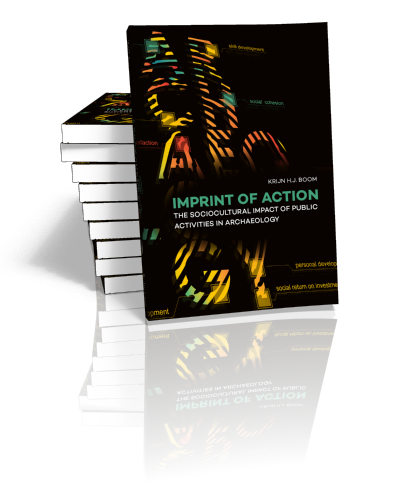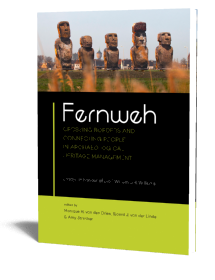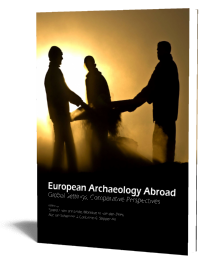Imprint of Action
The Sociocultural Impact of Public Activities in Archaeology
Krijn H.J. Boom | 2018

Imprint of Action
The Sociocultural Impact of Public Activities in Archaeology
Krijn H.J. Boom | 2018
Paperback ISBN: 9789088906992 | Hardback ISBN: 9789088907005 | Imprint: Sidestone Press Dissertations | Format: 182x257mm | 242 pp. | Language: English | 40 illus. (bw) | 61 illus. (fc) | Keywords: sociocultural impact, cultural heritage, archaeology, heritage management, public archaeology, community archaeology, societal value | download cover
Read online or downloaded 429 times
-
Digital & Online access
This is a full Open Access publication, click below to buy in print, browse, or download for free.
-
Buy via Sidestone (EU & UK)
-
Buy via our Distributors (WORLD)
For non-EU or UK destinations you can buy our books via our international distributors. Although prices may vary this will ensure speedy delivery and reduction in shipping costs or import tax. But you can also order with us directly via the module above.
UK international distributor
USA international distributor
-
Bookinfo
Paperback ISBN: 9789088906992 | Hardback ISBN: 9789088907005 | Imprint: Sidestone Press Dissertations | Format: 182x257mm | 242 pp. | Language: English | 40 illus. (bw) | 61 illus. (fc) | Keywords: sociocultural impact, cultural heritage, archaeology, heritage management, public archaeology, community archaeology, societal value | download cover
Read online or downloaded 429 times

We will plant a tree for each order containing a paperback or hardback book via OneTreePlanted.org.
Cultural heritage, which includes archaeology, is recognized as serving an increasingly important role in European societal development. But what exactly is the relevance of archaeology to present day citizens? Imprint of Action investigates the sociocultural impact of archaeology through public activities. These activities provide an ideal setting for research, as they represent a structured point of encounter between the public and archaeological heritage; in analysing them, aspects of people’s connections to the past are revealed. As such this research forms an integral part of the NEARCH project (2013-2018).
As a basis for analysis, survey data from three large-scale case studies – ‘DOMunder’ (Netherlands), ‘You(R ) Archaeology’ (Cross-Europe), and ‘Invisible Monuments’ (Greece) was used. The analysis and interpretation of the case studies is based on a newly created methodological framework which finds its roots in the broader culture and arts sector. Results shows that activities encourage participation and interaction, which engenders sociocultural impacts on participants, most notably in knowledge increase, skill development, social relations, and happiness.
Imprint of Action is the first large-scale study focussing entirely on sociocultural impact in archaeology and, as such, is explorative in nature; it provides unique insights into the workings of interaction and participation in archaeological events, and openly shares qualitative and quantitative research data with the expanding field. In doing so, Imprint of Action lies the foundations for further analysis of the societal impact of both large-and small-scale heritage projects and identifies the incontestable values of archaeological heritage to the public.
1. Introduction
The value of cultural heritage and archaeology
Theoretical framework
Methodological framework
Research objectives and deliverables
Contents of this thesis
2. Theoretical and methodological framework
Introduction
The concept of cultural heritage
Value assessment and value typology
Societal value of cultural heritage
Value of participation in archaeology
Sociocultural impact as a theoretical framework
Introduction
Impact versus value
Sociocultural impact in cultural heritage
Sociocultural impact as a methodological framework
Introduction
Online and face-to-face surveys
From goals to indicators to survey questions
Analysis and interpretation of the results
3. Case Study: DOMunder
Introduction
Research goals for this case study
About DOMunder
History of the Domplein Square
The creation of DOMunder
The surveys
Introduction
Methodology
Results
Visitor survey
Resident survey
Volunteer survey
Wrapping up results
Research goals
Activity goals
4. Case Study: You(R ) Archaeology
Introduction
Research goals for this case study
About the You(R ) Archaeology contest
The surveys
Introduction
Methodology
Results
Demographics
Local image and identity
Personal development
Social cohesion
Community empowerment and self-determination
Imagination and vision
Health and wellbeing
Wrapping up results
Research goals
Activity goals
5. Case Study: Invisible Monuments
Introduction
Research goals for this case study
About the Invisible Monuments, Digital Memory event
The surveys
Introduction
Methodology
Results
Demographics
Local image and identity
Personal development
Social cohesion
Community empowerment and self-determination
Imagination and vision
Health and wellbeing
Wrapping up results
Research goals
Activity goals
6. Discussion
Introduction
Comparing the case studies
Comparing activity goals
Comparing results of the surveys
Recommendations – a ‘step-by-step’ guideline
Cost Benefit of the case studies
Sustainable Development
Introduction
Emergence of the concept (within cultural heritage management)
Adding to the triple bottom line: culture as a fourth pillar
Discussion
7. Conclusion
Acknowledgements
References
List of Figures
List of Tables
Appendices
Appendix A1a: The DOMunder visitor survey (English)
Appendix A1b: The DOMunder visitor survey (Dutch)
Appendix A2a: The DOMunder resident survey (English)
Appendix A2b: The DOMunder resident survey (Dutch)
Appendix A3: the DOMunder volunteer survey (Dutch)
Appendix B1: The You(R ) Archaeology participant survey
Appendix C1: The Invisible Monuments visitor survey
Summary
Samenvatting

Dr. Krijn H.J. Boom
Krijn Boom started his career with a PhD on the sociocultural impact of public activities in archaeology. Subsequently, he was a post-doctoral researcher in heritage management at the Faculty of Archaeology of Leiden University and Project Manager Blended Learning at the University of Amsterdam. Krijn also co-founded the VALUE project – for research and outreach on the past, heritage, and video games. Currently, Krijn is an education consultant and publisher for Acco, a Flemish academic publishing company. Here, he combines his love for digital innovations in the didactic process with established media, in an ongoing quest to find the optimal ways to transfer knowledge and engage audiences.
Abstract:
Cultural heritage, which includes archaeology, is recognized as serving an increasingly important role in European societal development. But what exactly is the relevance of archaeology to present day citizens? Imprint of Action investigates the sociocultural impact of archaeology through public activities. These activities provide an ideal setting for research, as they represent a structured point of encounter between the public and archaeological heritage; in analysing them, aspects of people’s connections to the past are revealed. As such this research forms an integral part of the NEARCH project (2013-2018).
As a basis for analysis, survey data from three large-scale case studies – ‘DOMunder’ (Netherlands), ‘You(R ) Archaeology’ (Cross-Europe), and ‘Invisible Monuments’ (Greece) was used. The analysis and interpretation of the case studies is based on a newly created methodological framework which finds its roots in the broader culture and arts sector. Results shows that activities encourage participation and interaction, which engenders sociocultural impacts on participants, most notably in knowledge increase, skill development, social relations, and happiness.
Imprint of Action is the first large-scale study focussing entirely on sociocultural impact in archaeology and, as such, is explorative in nature; it provides unique insights into the workings of interaction and participation in archaeological events, and openly shares qualitative and quantitative research data with the expanding field. In doing so, Imprint of Action lies the foundations for further analysis of the societal impact of both large-and small-scale heritage projects and identifies the incontestable values of archaeological heritage to the public.
Contents
1. Introduction
The value of cultural heritage and archaeology
Theoretical framework
Methodological framework
Research objectives and deliverables
Contents of this thesis
2. Theoretical and methodological framework
Introduction
The concept of cultural heritage
Value assessment and value typology
Societal value of cultural heritage
Value of participation in archaeology
Sociocultural impact as a theoretical framework
Introduction
Impact versus value
Sociocultural impact in cultural heritage
Sociocultural impact as a methodological framework
Introduction
Online and face-to-face surveys
From goals to indicators to survey questions
Analysis and interpretation of the results
3. Case Study: DOMunder
Introduction
Research goals for this case study
About DOMunder
History of the Domplein Square
The creation of DOMunder
The surveys
Introduction
Methodology
Results
Visitor survey
Resident survey
Volunteer survey
Wrapping up results
Research goals
Activity goals
4. Case Study: You(R ) Archaeology
Introduction
Research goals for this case study
About the You(R ) Archaeology contest
The surveys
Introduction
Methodology
Results
Demographics
Local image and identity
Personal development
Social cohesion
Community empowerment and self-determination
Imagination and vision
Health and wellbeing
Wrapping up results
Research goals
Activity goals
5. Case Study: Invisible Monuments
Introduction
Research goals for this case study
About the Invisible Monuments, Digital Memory event
The surveys
Introduction
Methodology
Results
Demographics
Local image and identity
Personal development
Social cohesion
Community empowerment and self-determination
Imagination and vision
Health and wellbeing
Wrapping up results
Research goals
Activity goals
6. Discussion
Introduction
Comparing the case studies
Comparing activity goals
Comparing results of the surveys
Recommendations – a ‘step-by-step’ guideline
Cost Benefit of the case studies
Sustainable Development
Introduction
Emergence of the concept (within cultural heritage management)
Adding to the triple bottom line: culture as a fourth pillar
Discussion
7. Conclusion
Acknowledgements
References
List of Figures
List of Tables
Appendices
Appendix A1a: The DOMunder visitor survey (English)
Appendix A1b: The DOMunder visitor survey (Dutch)
Appendix A2a: The DOMunder resident survey (English)
Appendix A2b: The DOMunder resident survey (Dutch)
Appendix A3: the DOMunder volunteer survey (Dutch)
Appendix B1: The You(R ) Archaeology participant survey
Appendix C1: The Invisible Monuments visitor survey
Summary
Samenvatting

Dr. Krijn H.J. Boom
Krijn Boom started his career with a PhD on the sociocultural impact of public activities in archaeology. Subsequently, he was a post-doctoral researcher in heritage management at the Faculty of Archaeology of Leiden University and Project Manager Blended Learning at the University of Amsterdam. Krijn also co-founded the VALUE project – for research and outreach on the past, heritage, and video games. Currently, Krijn is an education consultant and publisher for Acco, a Flemish academic publishing company. Here, he combines his love for digital innovations in the didactic process with established media, in an ongoing quest to find the optimal ways to transfer knowledge and engage audiences.
-
Digital & Online access
This is a full Open Access publication, click below to buy in print, browse, or download for free.
-
Buy via Sidestone (EU & UK)
-
Buy via our Distributors (WORLD)
For non-EU or UK destinations you can buy our books via our international distributors. Although prices may vary this will ensure speedy delivery and reduction in shipping costs or import tax. But you can also order with us directly via the module above.
UK international distributor
USA international distributor
- Browse all books by subject
-
Search all books

We will plant a tree for each order containing a paperback or hardback book via OneTreePlanted.org.
You might also like:
© 2025 Sidestone Press KvK nr. 28114891 Privacy policy Sidestone Newsletter Terms and Conditions (Dutch)








